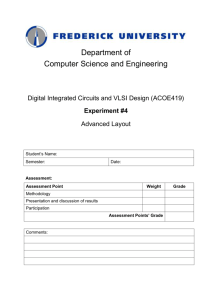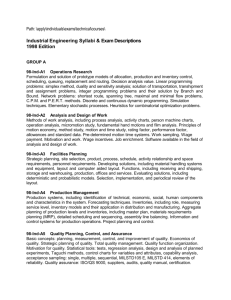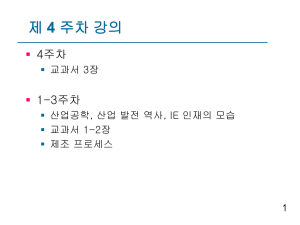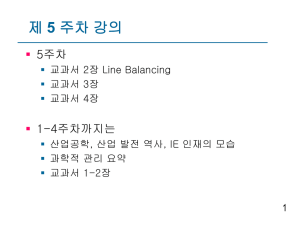EE466 VLSI Design
advertisement
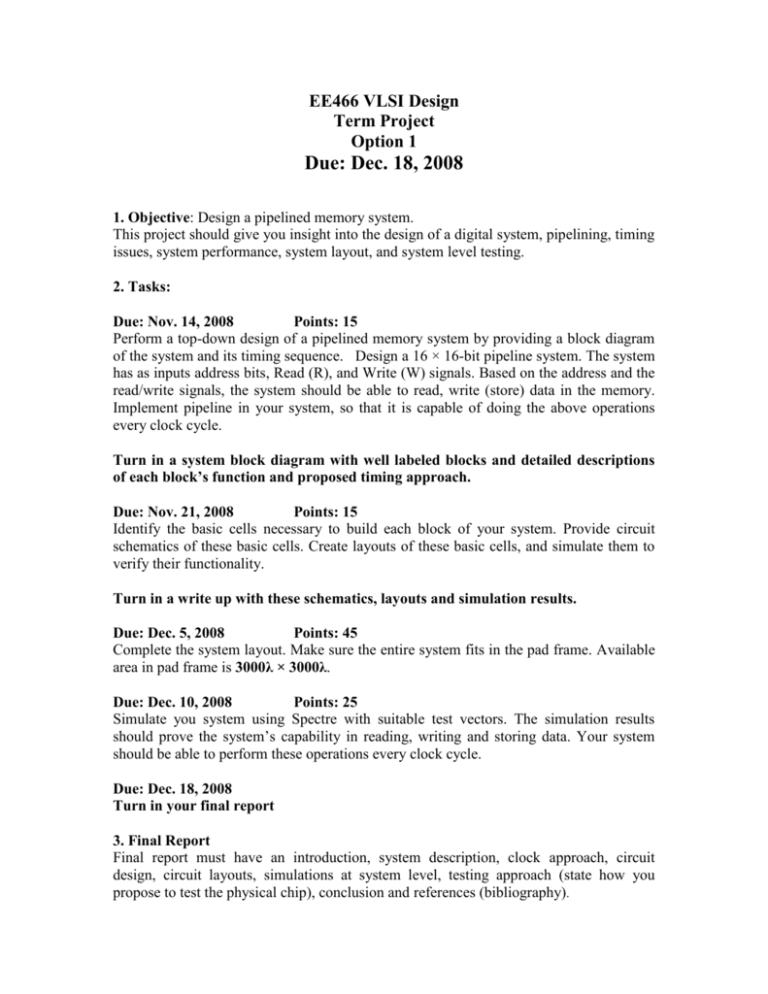
EE466 VLSI Design Term Project Option 1 Due: Dec. 18, 2008 1. Objective: Design a pipelined memory system. This project should give you insight into the design of a digital system, pipelining, timing issues, system performance, system layout, and system level testing. 2. Tasks: Due: Nov. 14, 2008 Points: 15 Perform a top-down design of a pipelined memory system by providing a block diagram of the system and its timing sequence. Design a 16 × 16-bit pipeline system. The system has as inputs address bits, Read (R), and Write (W) signals. Based on the address and the read/write signals, the system should be able to read, write (store) data in the memory. Implement pipeline in your system, so that it is capable of doing the above operations every clock cycle. Turn in a system block diagram with well labeled blocks and detailed descriptions of each block’s function and proposed timing approach. Due: Nov. 21, 2008 Points: 15 Identify the basic cells necessary to build each block of your system. Provide circuit schematics of these basic cells. Create layouts of these basic cells, and simulate them to verify their functionality. Turn in a write up with these schematics, layouts and simulation results. Due: Dec. 5, 2008 Points: 45 Complete the system layout. Make sure the entire system fits in the pad frame. Available area in pad frame is 3000λ × 3000λ. Due: Dec. 10, 2008 Points: 25 Simulate you system using Spectre with suitable test vectors. The simulation results should prove the system’s capability in reading, writing and storing data. Your system should be able to perform these operations every clock cycle. Due: Dec. 18, 2008 Turn in your final report 3. Final Report Final report must have an introduction, system description, clock approach, circuit design, circuit layouts, simulations at system level, testing approach (state how you propose to test the physical chip), conclusion and references (bibliography). EE466 VLSI Design Term Project Option 2 Due: Dec. 18, 2008 Objective The standard-cells based design is one of the most prevalent full custom design styles. In this design style, all of the commonly used logic cells are developed, characterized, and stored in a standard cell library. A typical library may contain a few hundred cells including inverters, NAND gates, NOR gates, memory cell, latches, and flip-flops. Each gate type can have multiple implementations to provide adequate driving capability for different fanouts. For instance, the inverter gate can have standard size transistors, double size transistors, and quadruple size transistors so that the chip designer can choose the proper size to achieve high circuit speed and layout density. For ease of cell placement and inter-cell routing (wires) in a large layout, each cell layout is designed with a fixed height, so that a number of cells can be placed side-by-side to form a grid layout. The power and ground rails typically run parallel to the upper and lower boundaries of the cell, so that all cells in a row can share a common power and ground rails. The nMOS transistors are located closer to the ground rail while the pMOS transistors are placed closer to the power rail. The objective of this project is to layout, simulate and characterize various logic cells for a standard cell library. Description In this project you can choose one among the following options. Each of these options has two cells. For the option you have chosen you are required to create layouts for both the cells. The layouts must be optimized for area, power, and performance (switching speed, drive strength). You must also provide a comparison between the two cells in terms of functionality and performance. Option 1: Decoupled Dynamic Content Addressable Memory Cells Refer to the paper: J. G. Delgado-Frias, J. Nyathi, S. B. Tatapudi, “Decoupled Dynamic Ternary Content Addressable Memories,” IEEE Transactions on Circuits and Systems-II, Volume 52, Issue 10, Oct. 2005, pp: 2139 - 2147 Implement the cells (a) 7.5-T DDCAM cell and (b) 10.5-T DDCAM cell. Option 2: Dual-Edge Triggered Storage Elements Refer to the paper: “Dual-edge triggered storage elements and clocking strategy for low-power systems” Nedovic, N.; Oklobdzija, V.G.; Very Large Scale Integration (VLSI) Systems, IEEE Transactions on Volume 13, Issue 5, May 2005 Page(s):577 - 590 Implement the cells (a) Transmission-gate latch-MUX and (b) CMOS latch-MUX. (pg. 583) Option 3: Delay Elements Refer to the following papers: An empirical and analytical comparison of delay elements and a new delay element Design Mahapatra, N.R.; Garimella, S.V.; Tareen, A.; VLSI, 2000. Proceedings, IEEE Computer Society Workshop on 27-28 April 2000 Page(s): 81 – 86 Implement the (a) Thyristor based delay element A digitally programmable delay element: design and analysis Maymandi-Nejad, M.; Sachdev, M.; Very Large Scale Integration (VLSI) Systems, IEEE Transactions on Volume 11, Issue 5, Oct. 2003 Page(s):871 – 878 Implement the (b) Digitally controlled delay element Option 4: 1-bit Full Adders Refer to your text book Chapter 10: Implement the (a) CMOS full adder (pg. 640) and (b) Transmission gate full adder (pg. 643) Note All the above papers can be found on IEEE Xplore. Please go to www.ieee.org, and use the IEEE Xplore to search for the papers mentioned. Milestones Milestones are used to ensure the timely and successful completion of the project. Please observe the following milestones. No extensions will be given on milestones. Milestone 1: Study of the cells to be implemented, implementation and simulation plan Due: Nov. 14, 2008 20 points You have to provide a detailed implementation and simulation plan (inputs, outputs, input drive used, output drive achieved etc.) for the cells you chose to implement. These will help in the layout and simulation of the cells. In simulation plan you should provide signals that would constitute the cell test patterns and the expected outputs. This could be just logic values. Vector inputs for all the possible input patterns should also be provided. Milestone 2: Complete layout and functional test of the cells. Due: Dec. 10, 2008 30 points You have to provide the completed layouts along with the functional test of the layouts. In the functional test you have to prove that the cell is in working condition. Milestone 3: Final report Due: Dec. 18, 2008 50 points A report with the detailed description of the cells implemented, working of the cells, detailed simulation results for the power, performance of the cell. Area optimizations must also be included in the final layouts and a discussion on the performance gains achieved due to such optimizations.
